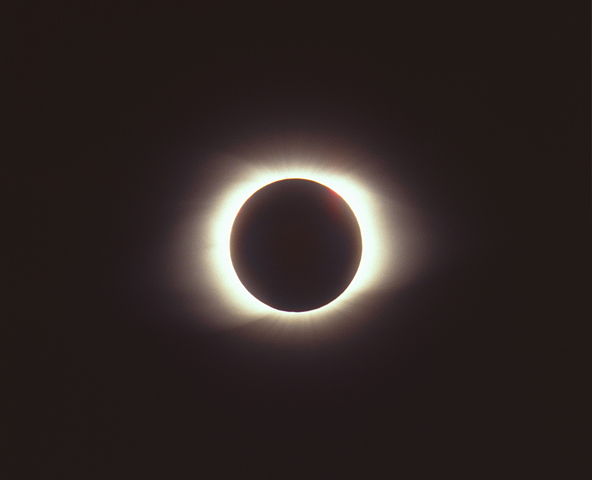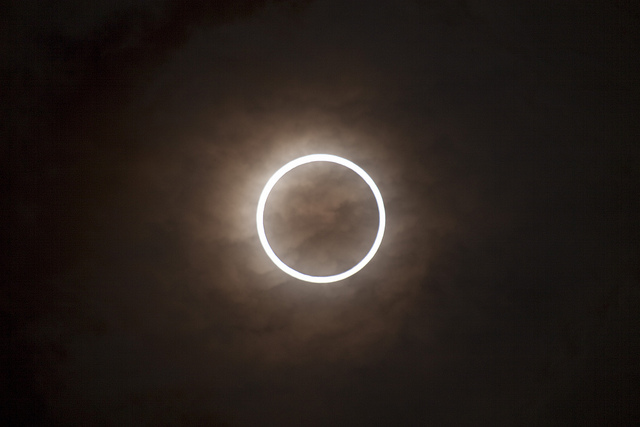Difference Between Annular Eclipse and Total Eclipse
Annular and total eclipses are the two most interesting solar eclipses seen in the history of mankind. There is a partial eclipse, and that is self-explanatory because that is when the Moon covers the Sun partially. The total and annular eclipses happen rarely, but modern science and astronomy technologies are able to predict the next occurrences. In this article, we unfold the difference between these eclipses.
What is a total eclipse?
The understanding of the total eclipse is demystified by understanding the elliptical orbit of the moon on the planet Earth. The Moon orbits around the Earth elliptically as the Earth does around the Sun. The space between the Earth and the Moon is not constant. The Moon occurs in phases and the eclipse happens when the New Moon phase emerges. Typically, Moon phases follow each other in this order: New Moon →New Crescent →1st Quarter → Waxing Gibbous → Full Moon →Waning Gibbous →Last Quarter →Old Crescent and finally the New Moon repeats.
The Moon basically has two shadows named penumbra and umbra. The total eclipse occurs during the umbra shadow. When the Moon is closer to the Earth, it obscures the Sun and thus a total eclipse occurs. See the picture below that illustrates this.
The aforementioned picture depicts the shadows of the Moon. Umbra is the inner shadow whereas penumbra is the outer shadow. When the narrow shadow of Umbra is long enough to fall on Earth, it obscures the Sun completely hence the total solar eclipse results. The total eclipse is, however, not visible from all locations on Earth.
Although the Moon phases change monthly, it does not necessarily mean there will be eclipses every month. Eclipses only occur during the New Moon which occurs every 29.5 days. Many calendars were predominantly based on the Moon’s monthly circles. The elliptical orbit of the Moon around the Earth is tilted at an angle of 5 degrees and so its shadow to the Earth varies, hence eclipses happen after a long time.
Still on the aforementioned picture, it shows that Umbra shadow results in the path of totality. It is about 10000 miles long and 100 miles in width. This path of totality is equivalent to 1% of the Earth’s surface. All people within the path of totality will experience the total eclipse. The frequency of at least a single total eclipse is annually. And, to see a total eclipse in the same location, one would wait for an average period of 375 years. It could be shorter or longer in any region.
The total eclipse lasts for few minutes. Basically, the Moon replaces the solar corona – the superhot bright part of the Sun in several minutes. See the 2006 total eclipse picture below:
What is Annular Eclipse?
As already highlighted, the distance between the Earth and the Moon is not constant. An annular eclipse occurs when the Moon is far away from the Earth. During this stage, the Umbra shadow is short to reach the Earth’s surface. As a result, the Moon only the part of the Sun thus leaving the small ring, also called annulus, where the sunlight is only visible around the edges of the Moon. An annular eclipse is alternatively called a central eclipse.
See the picture below that illustrates the occurrence of the annular eclipse.
The picture still shows the shadows of the Moon, viz. Penumbra and Umbra. The orbit of the Moon around the Earth may vary from 221000 miles to 252000 miles. This variance leads to the change in the size of the Moon. If far away, the Umbra is short and annular eclipse occurs. Annular eclipses are still damaging to eyes and thus precaution should be exercised. See the 2005 annular eclipse picture below:
When Penumbral shadow of the Moon reaches the Earth’s surface, a partial eclipse results. It is also too dangerous to view with naked eye.
Key differences between Annular and Total Eclipse
Definition of Annular and Total Eclipse
A total eclipse is a total cover of the Sun by the Moon when its Umbral shadow strikes the Earth. The Moon has two shadows, which are Umbra and Penumbra. These play a significant part in the total eclipse. Normally, the distance between the Moon and the Earth varies. When the Moon is closer to the Earth, the Umbra is long enough to reach our planet. A path of totality is created which leads to a black out of the Sun to the people covered by the path of totality.
An annular eclipse, on the other hand, is a partial cover of the Sun that leaves a small ring around the edges of the Moon. When the Moon is far away from the Earth, its Umbral shadow is too short to reach the Earth. This leads to an annular eclipse.
Danger to the eyes
A total eclipse is amazing to view and enjoy its photography because the superhot face of the Sun, the solar corona, is fully covered. One can view it with naked eyes but always exercise caution because the total eclipse lasts for a several minutes.
An annular eclipse is dangerous to the eyes. As thus, it should not be viewed with naked eyes. That small ring is still dangerous to the eyesight.
Occurrence of Annular and Total Eclipse
Both annular and total eclipse occur during New Moon phase. They may happen two times on average in a year but in different locations. The key difference here is that during an annular eclipse the Moon is far away from the Earth whereas it is closer during a total eclipse.
Annular Eclipse Vs. Total Eclipse: Comparison Chart
Summary of Annular Vs. Total Eclipse
- Annular eclipse occurs when the Moon covers the Sun partially thus leaving a small ring around the edges. Note that there is a dedicated partial eclipse when Penumbral shadow strikes the earth. There is also a hybrid eclipse where annular changes to the total eclipse and vice versa. But all these are rare
- Total eclipse occurs when the Sun is completely obscured
- Total eclipse happens when the Moon is closer to the planet Earth and the Umbral shadow is long enough to reach the Earth’s surface
- Annular eclipse happens when the Moon is far away thus resulting with a short Umbral shadow not enough to strike the Earth’s surface
- Annular eclipse needs to be viewed with aided telescopes because it is dangerous
- Total eclipse is less dangerous but lasts for several minutes before the solar corona reappears. Therefore, users need to be vigilant.
- Partial eclipses are more common than total eclipses.
- Difference Between CBD and Indica - April 22, 2019
- Difference Between Unilateral Contract and Bilateral Contract - February 8, 2019
- Difference Between Polki and Kundan - December 15, 2018
Search DifferenceBetween.net :
Leave a Response
References :
[0]Tyler Nordgren (13 Sep 2016). Sun Moon Earth: The History of Solar Eclipses from Omens of Doom to Einstein and Exoplanets. Basic Books – Science
[1]Fred Espenak (2009). Solar Eclipses for Beginners. Accessed at: http://www.mreclipse.com/Special/SEprimer.html. Accessed on 8 August 2018.
[2]Michael D. Reynolds, Richard A. Sweetsir (1995). Observe Eclipses. Astronomical League.
[3]Image credit: https://www.flickr.com/photos/nakae/7273334762
[4]Image credit: https://upload.wikimedia.org/wikipedia/commons/thumb/c/c5/Total_solar_eclipse_of_March_9_1997.jpg/592px-Total_solar_eclipse_of_March_9_1997.jpg



